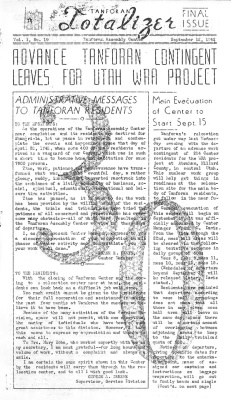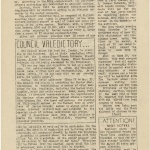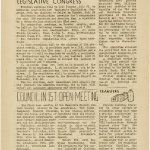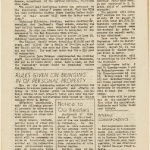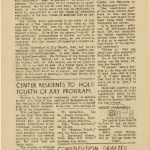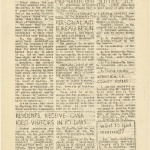Tanforan Totalizer (newspaper)
| Publication Name | Tanforan Totalizer |
|---|---|
| Camp | Tanforan (detention facility) |
| Start of Publication | May 15, 1942 |
| End of Publication | September 12, 1942 |
The Tanforan Totalizer was one of the fifteen newspapers published in temporary detention camps euphemistically called "assembly centers" and administered by the Wartime Civil Control Administration . The Totalizer debuted on May 15, 1942, and produced nineteen weekly mimeographed issues. It was edited throughout its run by Taro Katayama.
The Tanforan Assembly Center opened on April 28, 1942, and the Totalizer debuted on May 15. The four-page debut issue included an unsigned editorial that proclaimed that the Totalizer "is intended to be this center's paper in every way. Its interests are those of all the residents here. It is not the organ of any self-seeking group and it will not play any politics. It will seek to promote a democratic and cooperative spirit within the community as the basis of all action whether individual or collection." The issue also included a message from center manger Wm. R. Lawson. The paper steadily grew, going to six pages by issue three, eight pages by issue five and ten pages by issue 8, remaining at ten pages until the last two issues, the final issue being a twenty-six page finale.
The core editorial staff remained steady through the run of the paper. Editor Katayama was joined on the editorial staff by Bill Hata, Charles Kikuchi , Lillian Ota, and Jim Yamada (originally listed as the "editorial board") and Vic Abe, Haru Inouye, Evelyn Kirimura, Kay Nishida, Henri Takahashi, Warren Tsuneishi, and Ben Iijima (originally listed at "associate editors") and later Albert Nabeshima. The art and technical staff included Min Endo, Ham Hamasaki, Kimio Obata, Yuki Shiozawa, Bennie Nobori, Emiko Kikuchi, Marguerite Nose, Nobuo Kitagaki, and Sam Yanagisawa, while Alex Yorichi was in charge of circulation. Regular features included an "Out of Horse's Mouth" sports column, "The Kitchen," "With the Womenfolk," and "The Copy Boy Sez" by fourteen year old Albert Nabeshima. Of special note was the "Your Opinion Please" feature by future Japanese American Evacuation and Resettlement Study researcher Charles Kikuchi, which surveyed camp inmates on a variety of topics.
As with the other assembly center papers, editorial content was censored and the Japanese language prohibited. As such, the paper presented a world mostly devoid of Issei and of Nisei dissidents and tended to echo administration views. Historian Matthew Briones notes that its staff was "completely dominated" by "a liberal, or even radical group of Nisei " but that the heavy handed administration "afforded them no space for dissent." [1] For instance, elections and "self-government" are extolled in many early issues of the paper. Then, abruptly, the August 8 issue announced the dissolution of the elected council by army order without comment or rationale. The lack of diverse viewpoints can be seen in the June 6 issue report on a Town Hall Forum titled "What Should the Nisei Attitude Be Toward the Evacuation?" featuring four speakers "representing various viewpoints among the nisei." As the paper reported:
Kenji Fujii, the first speaker, said the nisei's attitude should be unfailingly grounded in his faith in his essential Americanism. Dave Tatsuno , a prominent member of the JACL and Ernest Takahashi both, in effect, counseled 'voluntary cooperation,' with the Federal program of evacuation. Warren Tsuneishi urged continued faith in democracy in meeting the problems of evacuation.
The 4th of July editorial alluded to injustice: "To some, both here and on the outside, our observance of America's Independence Day in this Center will undoubtedly seem to partake of the nature of a paradox. The surface irony of our situation is apparent enough," it read. But it went on to call on inmates to look beyond present hardships "and, in many cases, the seeming injustices" to "turn our thoughts to the future, both of this country and of our place in it. It is our task to grow to a fuller faith in what democracy can and will mean to all men."
The bulk of the paper covered the day-to-day issues that any newspaper covering a town of 8,000 people would cover: births, deaths, and weddings; announcements; event calendars, sporting results and opportunities; a police blotter, and even a lost and found. (The June 27 issue included a call for a set of lost false teeth.) Regular features on education, the library, and scouting, among other topics, grace most issues of the paper. There are also occasional short features profiling both notable inmates (singer Goro Suzuki—later to become famous after the war as " Jack Soo "—is profiled in the May 23 issue and artist Chiura Obata on June 6) and administrators.
The nineteenth and final issue of the Totalizer was dated September 12 and ran twenty-six pages. The issue included announcements and instructions about the upcoming move to Topaz as well as a look back over the past four months at Tanforan. The final summation on the last page seemed to allude to the limitations the editorial staff faced: "We have no illusions about what we've done--and left undone. Putting out a weekly mimeographed paper in an assembly center is, after all, likely to be more a matter of muscular exertion than of inspiration."
Tanforan closed on October 13, 1942. Editor Katayama went on to become the managing editor of the Topaz Times , with many of his Totalizer colleagues joining him there.
Footnotes
- ↑ Matthew M. Briones, Jim and Jap Crow: A Cultural History of 1940s Interracial America (Princeton: Princeton University Press, 2012), 125.
Last updated Feb. 21, 2020, 2:52 p.m..

 Media
Media
